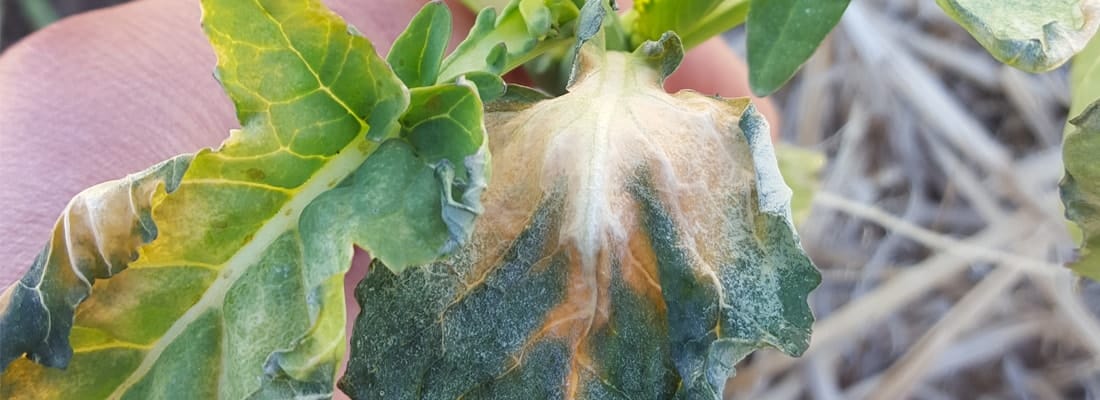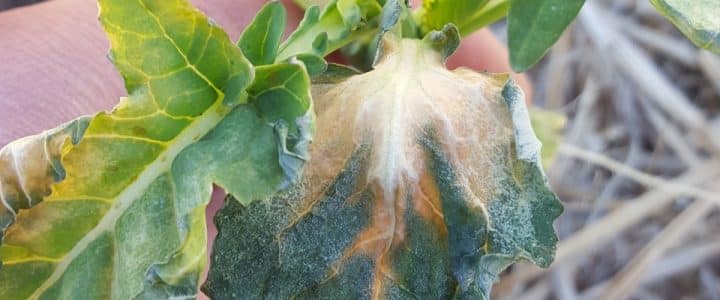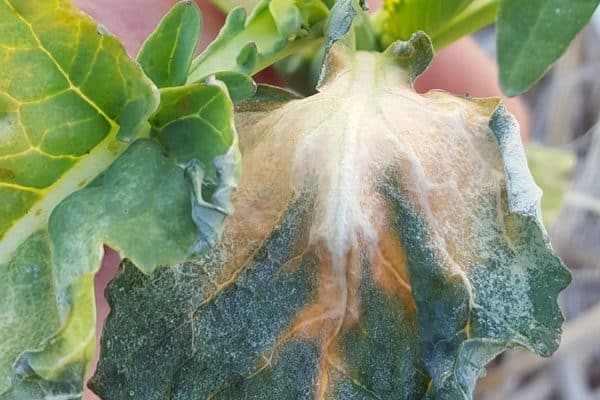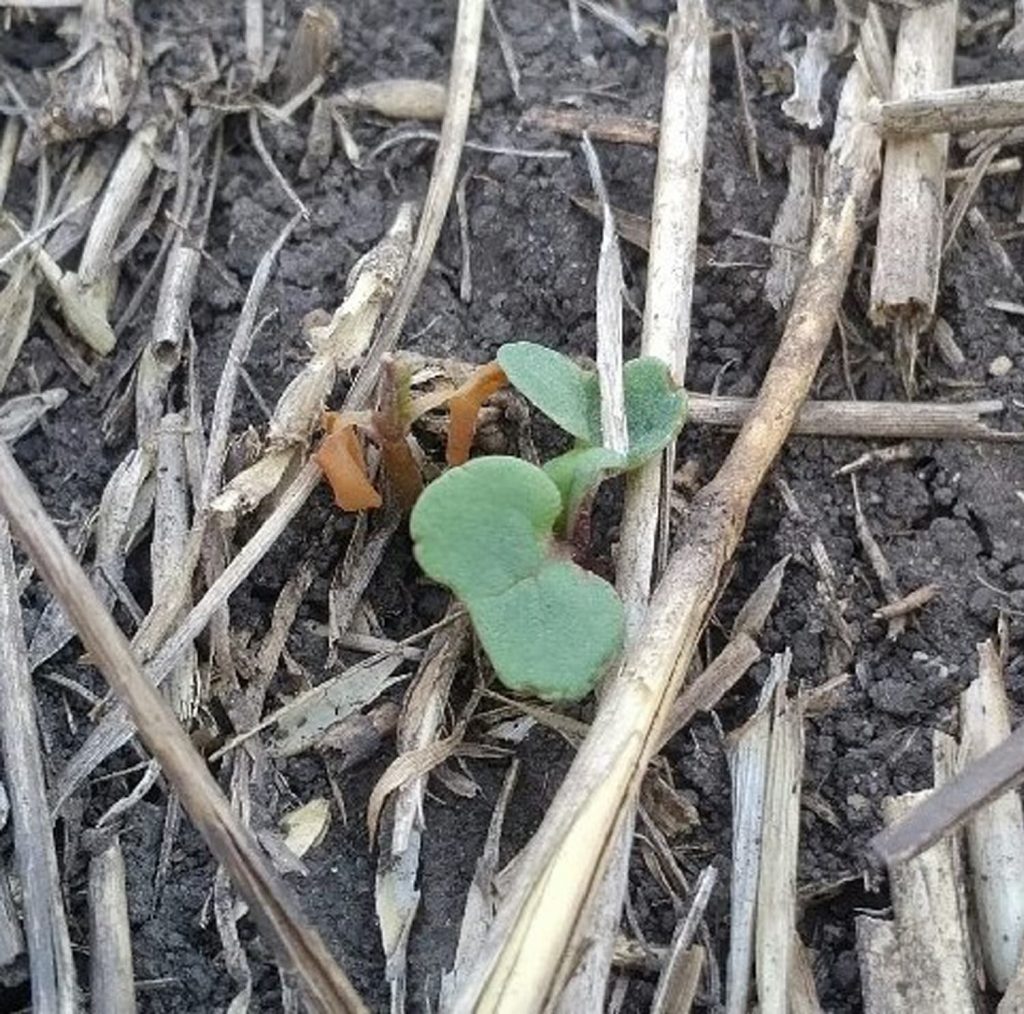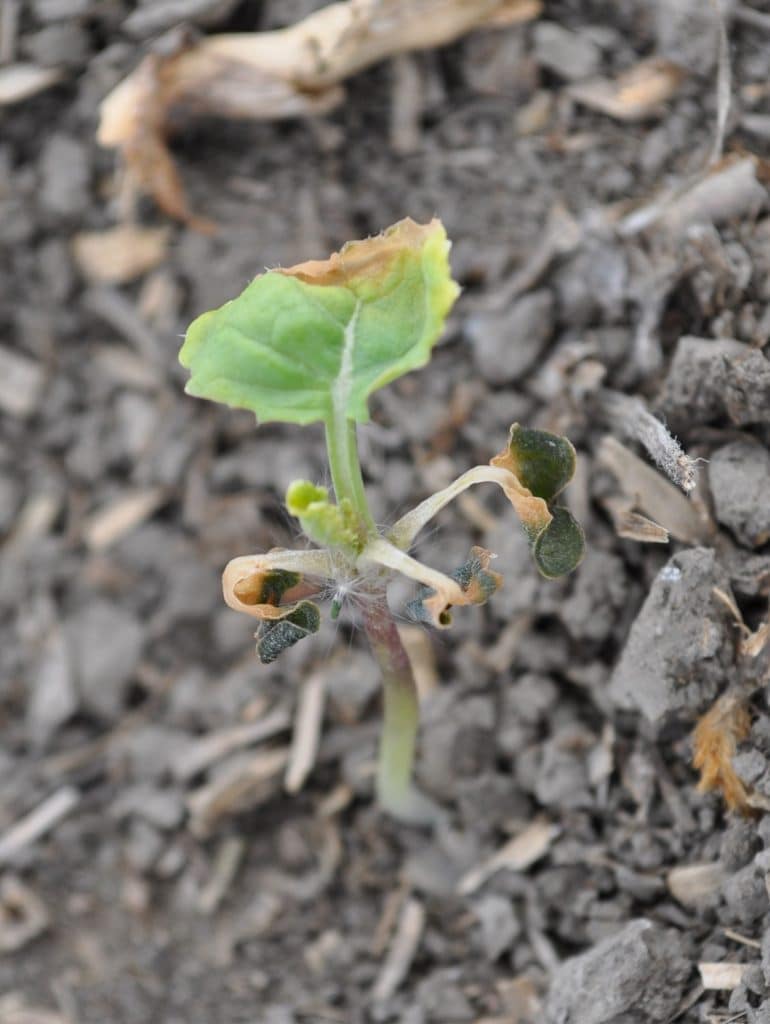Soil moisture and temperature (frost) are the most important environmental factors controlling stand establishment. Physical damage from wind, hail and excess water can also be a concern for canola plants at the early stages of development. Understanding the impacts of these environmental effects can help prepare growers to make informed management decisions, and set the crop up for success later in the growing season.
Important tips for best management
- Canola needs a moist seedbed with temperatures of two degrees Celsius or warmer for germination, the start of root growth, and ultimately emergence. Ideal temperatures for rapid germination and emergence are 10 degrees Celsius or higher.
- Early seeding in late April or early May can provide yield benefits in spite of cooler temperatures, as long as an adequate plant population survives. Starting to seed when soil temperatures in the seed zone reach four to five degrees Celsius is a reasonable compromise, or even earlier if the forecast is for temperatures to continue to increase following seeding.
- When conditions are dry, direct seedingA seeding method where the crop is sown into the field without any previous spring tillage operations. More and low disturbance openers will conserve seedbed moisture and improve germination and emergence.
- Consider the local frost risk when choosing a seeding date. The frost-free period varies considerably from location to location in Canada, and each year is different. Extreme variations of the dates of final spring frost and first fall frost may occur between years.
Seedbed moisture levels
Moist (not wet) seedbeds are ideal for canola germination. Semi-dry seedbeds often result in slow, uneven germination and increased abnormal seedlings.
Soil type influences the soil’s moisture-holding capacity. Clay soils have higher moisture storage capacity and tend to have better and quicker emergence than sandy loam soils, which have lower moisture storage capacity at 100 per cent field capacity (F.C.) (Table 1) 1.
Table 1. Emergence of canola at two soil moisture levels
Note: F.C. refers to field capacity
When sub-surface soil moisture in the spring is limited, it is important to take steps to conserve this moisture during seedbed preparation. For example, maintaining a firm seedbed can reduce the loss of moisture to the surface and atmosphere.
If irrigation is available prior to seeding canola, prepare the field for seeding and then irrigate enough to firm the surface and wet the soil to the level of sub-surface moisture, usually one to two centimetres (0.5-0.75 inch) deep. Leave the field to become surface dry and then seed. Do not irrigate between seeding and emergence, as this can potentially lead to soil crusting. Depending on the soil type and environmental conditions, a single irrigation application for germination and emergence is usually all that is required until the crop is in the four- to six-leaf stage. Avoid over-irrigation during this period, which can reduce the crop’s growth rate and increase the risk of seedling diseases.
Dry conditions
When seeding into dry soil conditions from March until mid-May, the recommendation of seeding to a depth of 1.25 centimetres to 2.5 centimetres (half an inch to one inch) remains. This is because there is still time for rain to provide moisture needed for germination and emergence. Seeding deeper also means seeding into cooler soil. Cool soil conditions combined with the longer distance seedlings must travel to reach the soil surface will mean higher seed and seedling mortality. In addition, deep seeding allows weeds emerging at the same time to get ahead of the crop. Furthermore, rain or wind can level seed-row furrows and create a much deeper seeding depth than initially intended, which makes targeting a deeper seed depth to access soil moisture even riskier. Other factors to consider regarding dry spring conditions include field topography, soil type, tillage method, seeding rate, seed-placed fertilizer and clubroot incidence. For more on these considerations, see this Canola Watch article.
Physical damage
Excess water
Canola is susceptible to excess water and water logging and a yield reduction at harvest after only three consecutive days of water logging during the growing season is common. Wet soils cause an oxygen deficiency in the soil, which reduces root respiration and growth. Additionally, this reduces nutrient uptake, and if conditions persist, plants can prematurely die or senesce.
Wet conditions can also cause leaching and denitrification of nitrogen and leaching of sulphur. Before investing in a top up application of nitrogen and/or sulphate sulphur, wait and monitor crop recovery from saturated soils. In wet conditions, the plant roots may be too shallow and not be able to access nutrients once the soil begins to dry, which is why it is important to monitor this thoroughly.
Even if the soil does dry up quickly and the crop recovers, consider the potential implications of applying high rates of nitrogen in a top dress application before doing so. For example, nitrogen will stimulate plant growth; however, this can also lead to delayed maturity, increasing the risk of reduced seed quality and yield loss, if an early fall frost is of concern.
Crusting
Wet conditions followed by warm, sunny days can cause soil crusting, creating a physical barrier that stops seedlings from emerging. If a few plants have emerged, it may be best to leave them rather than take measures to break up the crust. Two plants per square foot in late May or early June can be a viable crop if managed properly. However, if it is early May and plants have not emerged and dead seedlings can be found below the soil surface, reseeding may be the best option moving forward.
If plants have not emerged and the majority of the seeds have not germinated, a light harrowing can help, but there is a lack of research to support this. Take care to ensure that the harrowing operation is not damaging germinated seedlings that are trying to emerge.
Using a roller may be worse than harrowing. Instead of cracking up the soil surface, a roller could compact the topsoil and make the situation worse.
Wind
Wind can blow seed and seedlings out of the ground or create a sandblasting effect that can damage and shear recently emerged plants or cause plants to tip over or break at the point of injury. This is more common in dry conditions and in lighter textured soils, where the crop will already be stressed. It can also be worse on hilltops and side slopes facing into the wind. Assess the whole field before making a decision to reseed, or consider only reseeding patches of the field that requires it. If the wind damage only affects small patches, or if the plant stand is still above 10-20 plants per square metre (one to two per square foot), then leaving the stand could be a better choice than reseeding the whole field.
Hail damage
If early season hail breaks off both cotyledons or snaps the stem, these plants usually do not survive. But while individual plants may die, a whole canola crop is fairly resilient to early season hail when it comes to overall yield potential. Canola can sometimes recover its yield potential at sub-optimal plant densities (below 30-40 plants per square metre or three to four plants per square foot) because the remaining seedlings take advantage of the reduced competition for light, moisture and nutrients. As a result, plants can grow larger, produce more branches, and develop more pods and seeds per pod, compensating for the lost plants. Regardless of that compensation, a thin stand will have less probability of achieving its maximum yield and it is likely to see delayed maturity, variable maturity and/or be less competitive with weeds.
Temperature
Seeding early can reduce the risk of damage to maturing plants from a fall killing frost, but cold soils (a potential challenge of early seeding) will delay emergence in the spring. This delay increases the risk of seedling disease damage, which reduces plant populations. Slow and uneven seed germination and emergence can result in thin, variable stands which can make it more difficult for timing in-season crop protection productsPesticides (herbicides, insecticides or fungicides) used to protect against or reduce the amount of damage caused by weeds, pest insects or plant diseases. More (e.g. herbicides, insecticides or fungicides) and lead to uneven and/or later maturity.
To determine soil temperature, insert a soil thermometer at seeding depth and record the temperature at 8:30 a.m. and 4:00 p.m. over a few days. Take an average of those readings. This provides a more accurate overall estimate of soil temperature conditions the germinating seed and emerging seedling will endure.
Generally, soil temperatures below 10 degrees Celsius result in progressively poorer germination and emergence 2. Various studies have shown that canola can germinate at constant temperatures of two degrees Celsius, but sustained low temperatures can damage the seed embryo, which reduces germination and growth.
Cold soils (less than five degrees Celsius) at seeding and throughout the two weeks following can increase mortality by 10 per cent to 20 per cent. Given the yield benefit of early seeding, soil temperatures of four to five degrees Celsius is a reasonable starting point.
When seeding based on soil temperature, keep in mind that calendar date is not a reliable indicator of soil temperature. The soil temperature variation between years and between fields can be very large.
Read more on this in the Timing of Seeding section.
Growing degree days
Days to 50 per cent germination for canola can be predicted based on how many growing degree days (GDDs) have accumulated since planting, provided soil moisture is adequate to stimulate germination. B. napusAlso referred to as Argentine canola, it is the species of canola currently commonly grown in Canada. More requires 75 to 120 GDDs (base zero degrees Celsius) to reach 50 per cent germination for all temperatures three degrees Celsius or higher. B. rapaAlso referred to as Polish canola, it is the less commonly grown species of canola currently grown in Canada. More requires 115 GDDs to reach 50 per cent emergence at temperatures above eight degrees Celsius 3. When calculating, start count GDDs the day after seeding (not the day of seeding).
Factors that influence soil temperature:
• In spring, soil tends to be warmer closer to the surface.
• Bare soil warms quicker than soils with surface residue or vegetation that reflects some of the solar radiation. When seeding depth and climatic conditions are the same, emergence in seedbeds without residues at the surface will be about one to two days sooner than in seedbeds with residues on the surface.
• Tillage influences soil temperatures by reducing crop residue and drying the soil. Dry soil warms faster than wet soil but moist soil has a greater heat storage capacity.
• South-facing fields warm more quickly than north-facing fields or level land. Snow also melts earlier on south-facing fields. South facing fields usually have a slightly longer growing season.
Frost
The temperature at which frost injury occurs varies with the moisture content in the plant’s tissues, the length of time the temperature remains below freezing, the soil surface’s ability to act as a reservoir for heat (minimizing the time the plants are exposed to freezing temperatures), and the weather previous to the frost. This last point can be important for frost resilience. Days of cooler weather can “harden” plants and make them more tolerant to frost. This is described in more detail under “Frost damage details” below.
There is no firm evidence that cotyledons are more or less frost tolerant than true leaves. A 1980s research project found that canola at the cotyledon stage can be more susceptible to frost damage than plants at the three- to four-leaf stage 4, however reported field observations have stated the opposite: Cotyledons have been less damaged than the larger plants due to proximity to the soil surface which can act as a heat sink.
Canola seedlings will usually recover from a light spring frost that does not damage the growing point of the plant. A light frost that wilts the leaves but does not cause any browning, will not injure the plants. With wilting, there may be some yellowing or whitening of leaves, especially under drought conditions.
Assessing frost damage
When a frost does blacken the cotyledons and/or leaves, no action should be taken for four to 10 days. It takes several days to determine the extent of damage and whether the growing points have been killed. If there is any green color at the growing points in the centre of the frozen leaf rosettes or the hypocotyls appear thick and not pinched off, most of the plants will recover and yields will be higher than if the field is worked and reseeded.
Under good growing conditions, green re-growth from the growing point should occur in four to five days. Under poor growing conditions (i.e. cold and/or dry) this may take up to 10 days.
Consider the percentage of plants killed the density and distribution of the plants that look like they will survive, the weed population and the time of year when evaluating frost damaged seedling fields.
To evaluate a frost damaged field, walk an “X” or “W” path across the field and note all plants that will survive in a quarter square metre hoop (or some square or hoop of known dimension) every 20 paces. This should result in 50 to 100 samples. Record an observation from each sample and use these counts to calculate the percentage of the field that has an adequate density of plants recovering.
Frost damage can appear in patches, as light damage across a field, or complete stand death. Since frost tends to flow and settle across the landscape like water, low lying areas often see greater damage.
With a light frost of zero degrees Celsius to minus two degrees Celsius, the risk of crop damage is minimal.
With a heavy frost that kills off the cotyledons or parts of true leaves, it will take a few days before new leaves will start emerging from the growing point. If no growth occurs within this time, the plant is likely dead. If the stem is pinched off or the plant flops over, the plant will likely die. The pinched off or broken stem cannot provide nutrients to the growing point. Dead cotyledons do not mean a dead plant. If the hypocotyl is green and healthy days after the frost, this plant has likely survived and will soon put out a first leaf.
The quickest way to accurately assess recovery is to mark individual plants that could recover and recheck these plants over the following few days.
If the majority of a field has a minimum of 20 to 40 recovering plants per square metre (two to four plants per square foot) with light weed pressure, the field should not need to be re-seeded. Fields with 10 to 20 plants per square metre (one to two plants per square foot) across the majority of a field can be adequate if managed carefully with today’s herbicide tolerant hybrid varieties. Thin stands such as these can sometimes yield up to 90 per cent of a normal stand seeded at an early date but will be later in maturity. The surviving plants will take advantage of the reduced competition for light, moisture and nutrients and grow larger, producing more branches, pods and seeds per pod. The surviving plants may require an extra five to eight days or longer to mature, but a reseeded crop will require an even longer growing period and have a greater risk of fall frost damage.
More frost scenarios and considerations are discussion on this Canola Watch podcast.
Frost damage details
Low temperatures injure plants primarily by inducing ice formation between or within cells. Water that surrounds plant cells freezes first (at about zero degrees Celsius), while the water within the cell contains dissolved substances that, depending on their nature and concentration, depress the freezing point of water several degrees. As the water around the cells becomes ice, more water vapor moves out of the cell and into the spaces around the cell where it freezes. The reduced water content of the cells further depresses the freezing point of the cell water. This could continue, up to a point, without damaging the cell, but below a certain point, ice crystals form within the cell, disrupt the cell membrane and injure the cell.
The length of time of freezing temperatures is important. A severe drop in temperature which only lasts a very short time may not damage canola plants, while a light frost of a few degrees that lasts all night may cause severe damage. The amount of frost injury will depend on moisture conditions, rate at which thawing occurs, the growth stage of the plant, and the amount of cold temperature hardening the plant has experienced.
After several days of near freezing temperatures, early seeded canola will undergo a gradual hardening process that will allow the plants to withstand freezing temperatures without serious damage. It is likely that cold weather sets off a chain of plant gene activities that produce or degrade proteins that protect cells. Plants growing under these conditions are slower growing, producing smaller cells that have a higher concentration of soluble substances more resistant to frost damage.
Rapidly growing canola seedlings are more susceptible to frost damage than plants that are growing slowly under cold conditions, especially when there is ample moisture. Exposure to warm weather can cause cold hardened plants to lose frost tolerance and, like unhardened later-sown canola, be killed by temperatures of only minus three degrees Celsius to minus four degrees Celsius.
The frost-free period varies considerably between locations in Canada. Significant variations usually occur on a local scale and extreme variations of the dates of spring and fall frost may occur between years.
Frost and weed control
Weeds stressed and weakened by frost are not more susceptible to herbicide. The performance of some crop protection productsPesticides (herbicides, insecticides or fungicides) used to protect against or reduce the amount of damage caused by weeds, pest insects or plant diseases. More declines below (or above) certain temperatures and life science companies may not be able to guarantee their products if applied too soon after a frost.
Review labels and performance restrictions on all crop protection productsPesticides (herbicides, insecticides or fungicides) used to protect against or reduce the amount of damage caused by weeds, pest insects or plant diseases. More before using them.
After a light frost, spraying could resume when the following conditions are met:
• A minimum of one night with minimum temperatures of five degrees Celsius (the minimum for biological activity to occur).
• A minimum of one day of good growing conditions (warm and sunny) have passed.
• Good growing conditions (warm and sunny) are present at the time of spraying.
• There is no evidence of frost damage (blackening and water soaked appearance) on the crop or the weeds. Note that even herbicide tolerant hybrids require that the metabolism of the plant be working at full capacity to enable it to effectively process the herbicide and prevent injury.
After a heavy frost, check for damaged tissues such as water soaked and darkened leaves that eventually lead to necrosisA symptom of plant cell or plant tissue death. More (dead, dry tissue). If tissue damage is greater than 40 per cent of total leaf area, allow new leaves to grow before making herbicide applications.
Heat at flowering
Effect of hot weather on canola flowering and yield
Brassica napusAlso referred to as Argentine canola, it is the species of canola currently commonly grown in Canada. More is considered a cool season crop and, as such, can face considerable yield loss when hot weather occurs during flowering in Western Canada.
W. F. (Wes) Nuttall et al. analyzed the effect of July and August temperatures on canola over a 16-year period in Saskatchewan from 1975-1990. When the average daily maximum temperature for July and August increased from 21 degrees Celsius to 24 degrees Celsius, the result was a 0.4 tonne per hectare (approximately seven bushels per acre) reduction in canola grain yield 5.
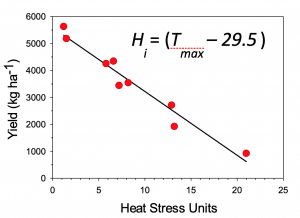
In plot studies at Agriculture and Agri-Food CanadaAgriculture and Agri-Food Canada is a department of the Government of Canada. More (AAFCAgriculture and Agri-Food Canada is a department of the Government of Canada. More) Ottawa from 1989 to 1991, Malcolm Morrison found that yield loss for Brassica rapaAlso referred to as Polish canola, it is the less commonly grown species of canola currently grown in Canada. More, B. napusAlso referred to as Argentine canola, it is the species of canola currently commonly grown in Canada. More and B. junceaAlso referred to as brown mustard, it is a minor crop (from the Cruciferae or Brassicaceae plant family, commonly known as the mustard family) grown in Canada. More would start to occur when temperatures during flowing exceeded 29.5 degrees Celsius. As part of the study, Morrison measured the accumulation of “heat stress units” and found that as the daily maximum temperature increased beyond the 29.5 degrees Celsius threshold and as flowering canola experienced multiple hot days, the yield loss became steadily worse 6.
Sangamesh Angadi studied the same three Brassica species to see if plants could flower longer to compensate for lost yield due to high temperatures at the beginning of flowering 7. In that study, Angadi found that extended flowering and podding on side branches could help, but did not come close to making up for lost yield. Angadi’s data show seed yield on the main stem was reduced by 89 per cent due to heat stress. Even with compensation by pods on branches, the final yield loss was still 52 per cent. Angadi also noted that, Brassica napusAlso referred to as Argentine canola, it is the species of canola currently commonly grown in Canada. More, which produced many abnormal pods during recovery, had the least ability to recover from severe stress at flowering of the three Brassica species.
In the 2000s, Randy Kutcher did another analysis of historical (1967 to 2001) weather and crop yield data from Saskatchewan. Kutcher’s data showed a yield loss of approximately seven per cent for each 1 degree Celsius increase in average growing-season temperature. (Generally speaking, warm years have lower yields and cool years have higher yields.) Kutcher also found that yields dropped 12 per cent below average if fields experienced a week of temperatures above 30 degrees Celsius, no matter the growing season average. Kutcher added, as have others, that while dry conditions make the heat effect worse, heat can have a severe yield effect even with adequate moisture 8.
Kutcher noted the importance of the first 14 days of flowering. In his published report, he cited a 1975 study (by Tayo and Morgan) that found 75 per cent of B. napusAlso referred to as Argentine canola, it is the species of canola currently commonly grown in Canada. More pods present at maturity develop from flowers that open within 14 days of the beginning of flowering. Kutcher concluded that high temperature during this 14-day period is expected to have the greatest impact on seed yield, which would match with Angadi’s results.
Kutcher also demonstrated that warm nights in combination with hot days throughout the growing season can increase yield loss, while high-yielding years reported lower nocturnal temperatures.
Jenelle White also analyzed the effect of warm nights in a more recent study. White found that canola yield reductions across Saskatchewan from 2010 to 2015 were associated with nocturnal temperatures in excess of 15 degrees Celsius. In a conclusion similar to Kutcher’s, White also found that higher yields had significant associations with cooler daily maximum temperatures (lower than 26 degrees Celsius) and cooler nocturnal temperatures (lower than 12 degrees Celsius) 9.
Many of these older studies were looking at results for open-pollinated (OP) cultivarsCultivars are variants in a species developed through the intervention of humans (despite the term 'variety' often being incorrectly used to describe this). Cultivars can be open-pollinated type, hybrid, synthetic, composite, etc. More. In a study that compared hybrids and OPs, Chad Koscielny showed that hybrids may have more tolerance to heat stress, but they still experience costly yield loss. In a field study that compared early and late planting dates to demonstrate temperatures effects on flowering and yield, Koscielny showed a heat-induced 20 per cent reduction in yield for hybrids and 25 per cent reduction in yield for open-pollinated cultivarsCultivars are variants in a species developed through the intervention of humans (despite the term 'variety' often being incorrectly used to describe this). Cultivars can be open-pollinated type, hybrid, synthetic, composite, etc. More 10.
Koscielny’s research supported earlier observations by Malcolm Morrison showing considerable differences in heat stress tolerance among canola cultivarsCultivars are variants in a species developed through the intervention of humans (despite the term 'variety' often being incorrectly used to describe this). Cultivars can be open-pollinated type, hybrid, synthetic, composite, etc. More. This means breeders could select for canola cultivarsCultivars are variants in a species developed through the intervention of humans (despite the term 'variety' often being incorrectly used to describe this). Cultivars can be open-pollinated type, hybrid, synthetic, composite, etc. More with higher heat stress tolerance. In his report, Koscielny wrote: “When more tolerant inbreds are used to produce hybrids, the resulting hybrids are more tolerant. Inversely, when two susceptible inbreds are combined, the resulting hybrids are susceptible, suggesting an additive genetic effect. This indicates that breeders can screen inbreds for heat tolerance, which will provide increased phenotypic variation and predictive information for hybrid combinations” 10.
What does heat do to canola flowers?
Heat stress does not seem to affect flower production, but it can have a severe effect on the fertility of those flowers and subsequent pod and seed production 11.
Malcolm Morrison growth cabinet experiments showed that B. napusAlso referred to as Argentine canola, it is the species of canola currently commonly grown in Canada. More grown in the hot cabinet produced short plump pods that did not contain seeds. These seedless plump pods may have been the result of parthenocarpy – a situation where successful pollination could have stimulated ovary development but failure of fertilization prevented seed development 12.
Morrison’s experiments show that heat damage to canola yield starts at around 29.5 degrees Celsius, but that pollen sterility could still be maintained at these temperatures. Therefore, Morrison concluded that something else other than or in addition to pollen sterility (male) is the cause for missing pods and lower seed set. Morrison found that pollen tubes (female) grew best at temperatures of 20 degrees Celsius to 23 degrees Celsius, and theorized that heat stress may cause changes in recognition proteins on the surface of the stigma which identify self pollen as foe and does not allow hydration or penetration of the pollen tube 13.
Lester Young et al. also found that heat stress (up to 35 degrees Celsius in the growth chamber study) had effects on flowers that are already fertilized and on flowers yet to be fertilized. Young showed that the effects of heat stress lingered up to eight days past the end of the heat stress period, concluding that heat does more than just cause flower abortion. It also damages gametophyte (pollen and pollen tube) development and/or function 14.
In another growth chamber study, Baoluo Ma and his post-doctoral fellow Wei Wu put some numbers to the heat effect. The study compared two temperature treatments: maximum 23 degrees Celsius and minimum 17 degrees Celsius, which was the control, and maximum 27 degrees Celsius and minimum 24 degrees Celsius. The high temperature treatment reduced seed yield by 33.8 per cent. This yield loss was the result of a 16.0 per cent reduction in the total filled pod number, 27.5 per cent reduction in the success ratio of developed pods and 42.4 per cent reduction in pollen viability in comparison with those under the control condition 15.
In specific reference to reproduction, Ma found that heat stress reduces pollen viability and its germination on the stigma, resulting in pollination failure and causing floral buds, flowers and pods to shed. This heat stress also reduced seed set on the main stem and primary branches, which is why an obvious result of heat stress is missing pods along the stem.
Raju Soolanayakanahally, in an AAFCAgriculture and Agri-Food Canada is a department of the Government of Canada. More Saskatoon greenhouse study on the effects of heat and drought on canola performance, found that high day-time temperatures led to stunted flowers, shrunken stamens and shrivelled petals. The published report noted that heat reduced photosynthetic activity in general and, with specific regard to canola flowers, altered the gametogenesis (of pollen and ovules in flowers), embryo sac differentiation, fertilization, and post-fertilization structures, such as the growth of the endosperm and the embryo. The result was a 43 per cent decrease in the number of pods and an 85.3 per cent reduction in seed yield when compared to canola plants grown under more moderate temperatures 16.
Footnotes
- Nuttall, W. F. 1982. The Effect of Seeding Depth, Soil Moisture Regime, and Crust Strength on Emergence of Rape CultivarsCultivars are variants in a species developed through the intervention of humans (despite the term 'variety' often being incorrectly used to describe this). Cultivars can be open-pollinated type, hybrid, synthetic, composite, etc. More. Agronomy Journal, 74(6), 1018-1022. doi:10.2134/agronj1982.00021962007400060020x[↩]
- Christensen, J.V., Legge, W.G., DePauw, R.M., Henning, A.M.F., McKenzie, J.S., Siemens, B., & Thomas, J.B. 1985. Effect of seeding date, nitrogen and phosphate fertilizer on growth, yield and quality of rapeseed in northwest Alberta. Canadian Journal of Plant science. Revue Canadienne de Phytotechnie. 65(2), 275-284. DOI: 10.4141/cjps85-040.[↩]
- Vigil, M.F., R.L. Anderson, & W.E. Beard. 1997. Base temperature and growing-degree-hour requirements for the emergence of canola. Crop Sci., 37, 844-849.[↩]
- Dhawan, A.K. 1985. Freezing in oil-seed Brassica spp.: some factors affecting injury. The Journal of Agricultural Science, 104, 513-518.[↩]
- Nuttall, W.F., Moulin, A.P., & Townley‐Smith, L.J. 1992. Yield response of canola to nitrogen, phosphorus, precipitation and temperature. Agronomy Journal, 84(5), 765-768. https://doi.org/10.2134/agronj1992.00021962008400050001x[↩]
- Morrison, Malcolm & Stewart, Doug. 2002. Heat Stress during Flowering in Summer Brassica. Crop Science, 42, 797-803. https://doi.org/10.2135/cropsci2002.7970[↩][↩]
- Angadi S. V., Cutforth, H. W., Miller, P. R., McConkey, B. G., Entz, M. H., Brandt, S. A., & Volkmar, K. M. 2000. Response of three Brassica species to high temperature stress during reproductive growth. Can. J. Plant Sci., 80, 693–701.[↩]
- Kutcher, H.R., Warland, J.S., & Brandt, S. 2010. Temperature and precipitation effects on canola yields in Saskatchewan, Canada. Agricultural and Forest Meteorology, 150, 161-165. https://doi.org/10.1016/j.agrformet.2009.09.011[↩]
- White, Jenelle, Berg, Aaron A., Champagne, Catherine, Warland, Jon, & Zhang, Yinsuo. 2019. Canola yield sensitivity to climate indicators and passive microwave-derived soil moisture estimates in Saskatchewan, Canada. Agricultural and Forest Meteorology, 268, 354-362. https://doi.org/10.1016/j.agrformet.2019.01.004.[↩]
- Koscielny, C.B., Gardner, S.W., & Duncan, R.W. 2018. Impact of high temperature on heterosis and general combining ability in spring canola (Brassica napusAlso referred to as Argentine canola, it is the species of canola currently commonly grown in Canada. More L.). Field Crops Research, 221, 61-70. https://doi.org/10.1016/j.fcr.2018.02.014[↩][↩]
- Young, Lester, Wilen, Ron, & Bonham-Smith, Peta. 2004. High temperature stress of Brassica napusAlso referred to as Argentine canola, it is the species of canola currently commonly grown in Canada. More during flowering reduces micro- and megagametophyte fertility, induces fruit abortion, and disrupts seed production. Journal of Experimental Botany, 55(396), 485-495. https://doi.org/10.1093/jxb/erh038[↩]
- Morrison, M. (Malcolm) J. 1993. Heat stress during reproduction in summer rape. Can. J. Bot. 71: 303-308.[↩]
- Morrison, Malcolm, Gutknecht, Allison, Chan, John, & Miller, Shea. 2016. Characterising canola pollen germination across a temperature gradient. Crop and Pasture Science, 67(4), 317-322. https://doi.org/10.1071/CP15230[↩]
- Young, L.W., Wilen, R.W., & Bonham-Smith, P.C. High temperature stress of Brassica napusAlso referred to as Argentine canola, it is the species of canola currently commonly grown in Canada. More during flowering reduces micro- and megagametophyte fertility, induces fruit abortion, and disrupts seed production. 2004. Journal of Experimental Botany, 55(396), 485-495. https://doi.org/10.1093/jxb/erh038[↩]
- Wu, Wei, Shah, Farooq, Duncan, Robert W., & Ma, Bao Luo. 2020. Grain yield, root growth habit and lodging of eight oilseed rape genotypes in response to a short period of heat stress during flowering. Agricultural and Forest Meteorology, 287, 107954. https://doi.org/10.1016/j.agrformet.2020.107954[↩]
- Soolanayakanahally, Raju, & Elferjani, Raed. 2018. Canola responses to drought, heat and combine stress: Shared and specific effects on carbon assimilation, seed yield and oil composition. Frontiers in Plant Science, 30. https://doi.org/10.3389/fpls.2018.01224[↩]
